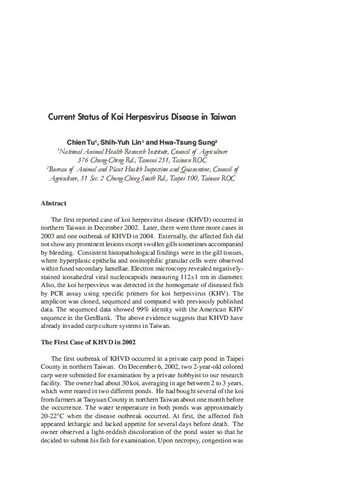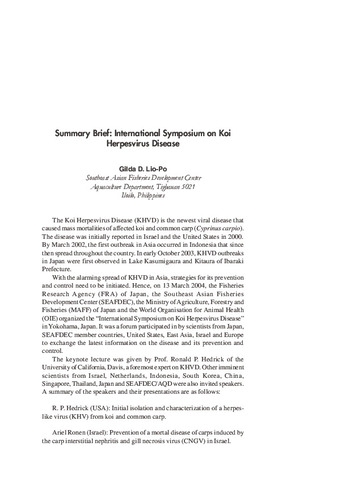Recent developments in the study and surveillance of koi herpesvirus (KHV) in Asia
- Global styles
- MLA
- Vancouver
- Elsevier - Harvard
- APA
- Help

Download URL
www.fhs-afs.netDate
2011Author
Page views
1,940AGROVOC keyword
Metadata
Show full item record
Share
Abstract
Koi herpesvirus infection causes significant mortalities in common carp (Cyprinus carpio carpio), koi carp (Cyprinus carpio koi) and ghost carp (common x koi cross, Cyprinus carpio koi). Outbreaks have been reported in many countries worldwide i.e. UK, Germany, Israel, USA, Belgium, South Africa, Switzerland, The Netherlands, France, Denmark, Austria, Italy, Luxemburg and Poland. The first outbreaks attributed to KHV in Asian countries were reported from Hong Kong in 2001; Indonesia in 2002; Taiwan in 2002; Japan in 2003; Thailand in 2005; and Singapore in 2005. Thereafter, research studies embarked on KHV focused on pathogenicity, cell line susceptibility, fish size susceptibility, predilection to fish organs, persistence in fish, vaccine development and application, surveillance and gene sequence analyses of KHV strains. To date, annual active surveillance of the virus in Cambodia, Lao PDR, Myanmar, the Philippines and Vietnam showed that these countries were free of KHV from 2004 to 2007. Several strains of KHV apparently affect koi and common carp in this region indicating that transboundary movement of the virus has occurred not only in Asia but also from Europe and the Americas. The extensive international trade in live ornamental koi fish has largely contributed to the global spread of KHV. Hence, KHV disease (KHVD) was recently added to the list of notifiable diseases of the World Organisation of Animal Health or the Office International des Epizooties (OIE), an indication of the global significance of this viral infection.
Suggested Citation
Lio-Po, G. D. (2011). Recent developments in the study and surveillance of koi herpesvirus (KHV) in Asia. In M. G. Bondad-Reantaso, J. B. Jones, F. Corsin, & T. Aoki (Eds.), Diseases in Asian Aquaculture VII (pp. 13-28). Selangor, Malaysia: Fish Health Section, Asian Fisheries Society.
Type
Conference paperCollections
- Conference Proceedings [299]
Related items
Showing items related by title, author, creator and subject.
-
Molecular epidemiology of koi herpesvirus
Kurita, Jun; Yuasa, Kei; Ito, Takafumi; Sano, Motohiko; Hedrick, Ronald P.; Engelsma, Marc Y.; Haenen, Olga L. M.; Sunarto, Agus; Kholidin, Edy Barkat; Chou, Hsin-Yiu; Tung, Ming-Chen; de la Peña, Leobert D.; Lio-Po, Gilda; Tu, Chien; Way, Keith; Iida, Takaji (Japanese Society of Fish Pathology, 2009)Three regions of koi herpesvirus (KHV) genomic DNA were compared for 34 samples from Japan, six from Indonesia, two from Taiwan, one from the Philippines, 13 from the Netherlands, one from the UK, one from the USA and one ... -
Current status of koi herpesvirus disease in Taiwan
Tu, Chien; Lin, Shih-Yuh; Sung, Hwa-Tsung (Aquaculture Department, Southeast Asian Fisheries Development Center, 2004)The first reported case of koi herpesvirus disease (KHVD) occurred in northern Taiwan in December 2002. Later, there were three more cases in 2003 and one outbreak of KHVD in 2004. Externally, the affected fish did not ... -
Summary brief: International symposium on koi herpesvirus diseases
Lio-Po, Gilda D. (Aquaculture Department, Southeast Asian Fisheries Development Center, 2004)The Koi Herpesvirus Disease (KHVD) is the newest viral disease that caused mass mortalities of affected koi and common carp (Cyprinus carpio). The disease was initially reported in Israel and the United States in 2000. By ...




